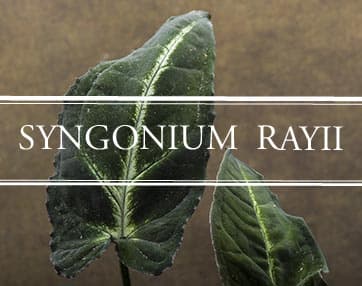Hemiepiphyte plants live half of their lives being rooted in the soil and the other half being epiphytes. Interesting? Let us know more. Syngonium rayii is a rare indoor plant popularly grown for its foliage. The velvety leaves are narrow in shape, have pointed tips, and dark green or blackish-green in color.
They have a white or silver-colored line running throughout the center which disappears from the latter half of the leaf on maturity. A fast-growing arrow-head philodendron is a nice option for making indoor decorative pots and as a background plant in terrariums and vivariums.
Let us get in some depth and know more about the evergreen perennial, S.rayii plant, its requirements, and propagation.
Syngonium Rayii Classification
Family: Araceae.
Subfamily: Aroid.
Genus: Syngonium.
Species: S. rayii.
Genus Syngonium
The genus belongs to the family Araceae and comprises flowering plants. These natives of rain forests of West Indies and South America, Syngoniums are plants with different forms in adult and juvenile stages in life. The plants make popular house plants in their young stage and remain the same in the absence of growing space. The adult stage usually consists of around 15-meter tall vines with woody stems.
On the base of leaf structure, this genus is informally divided into the following categories;
- Cordatum
- Oblongatum.
- Pinnatilobum.
- Syngonium.
Syngonium Rayii Other Names
The Common names of the plant are;
- Arrowhead plant.
- A. head vine.
- Arrowhead philodendron.
The term arrowhead refers to the typical arrow-like shape of the leaves.
Plant Features
We are highlighting the basic features of the Rayii plant.
- The mature height of the plant is around 15 inches.
- An average leaf is about 5 to 7 inches long and 3 to 5 inches wide.
- The plant expands by producing stolons or runners.
Do you know what stoloniferous plants are?
Stolon is a botanical term for special stems that grow at the surface or under the ground. These stems from adventitious roots from the nodes and buds develop to form new plants.
Syngonium Rayii Care
The important facts about the care of the S.rayii plant are as under;
Water Requirement
The plants love moist soil but never bear overwatering. So, you can water your plant twice to thrice a week in summer and once a week in winter. Make sure the soil is at least 70% dry before you water again. Please avoid keep the plant wet or soggy, this will save the plant from many possible issues like fungus and root rot.
Sunlight Requirement
The optimal light situation is a shade to partial sun exposure. Make sure you avoid keeping the plant in direct sunlight. As direct sun exposure will burn the delicate Syngonium.
Temperature Requirement
What is the suitable temperature range for the Arrowhead Rayii plant?
The plant dwells well in the temperature range between is 45 to 95 degrees Fahrenheit.
Humidity Requirement
Just like other rainforest natives, the Syngoniums love humidity. A good moisture level will result in the form of lush foliage. If you feel that the atmosphere is dry, you can provide the desired moisture by mild misting. But make sure, the foliage does not remain wet for long. Alternatively, you can keep a pebble-tray under the plant pot or introducing a humidifying device in the room.
Soil Requirement
The soil or substrate should be well-drained. Any standing water at the base will result in root rot and other issues.
Fertilizer Requirement
In summer, you can fertilize the plant mildly, once a month in spring and spring. Take a suitable house plant fertilizer and use it according to the directions.
These plants don’t need much fertilizer on cold days. Thus, we recommend avoiding fertilizer after October until February.
Growth Zone
The plants in hardy in the growth zone
Toxicity
Is my Syngonium rayii plant toxic? Yes, just like other Syngoniums, the Rayii plant is also toxic in nature. It is mildly toxic for you and fully harmful for your pet cat and dog. Exposure and ingestion may result in ulceration on lips and mouths and even serious issues like vomiting and diarrhoea. Be safe and keep the pets and kids away from the rayii plant.
Syngonium Rayii Propagation
Do you want to propagate your Arrowhead Vine? This is easy to propagate the plant, even if you are a beginner gardener.
Common methods of propagation include;
- By shoot cuttings.
- By Stolons or Runners.
Propagation by Shoot Cuttings
Just select a newly growing shoot on a healthy parent plant and cut some 4 to 6 inches long cuttings. Now remove a few leaves from the lower side. Plant the cutting in good quality moist soil or some suitable houseplant substrate. Make sure to keep 2 to 3 nodes under the soil to enhance the growth process.
Alternatively, you can use a jar filled with water and root the cuttings in it. Try to get chlorine-free water, as this will save the cutting tips from getting brown and rotten.
Roots will start to develop in a period of about 3 to 4 weeks.
Propagation by Stolons
You can easily propagate a stoloniferous plant by cutting a stolon and planting it at the desired place. The runners will form new plants from their nodes and buds.
Related Post:
Summary
Syngonium rayii is a rare indoor plant, popularly grown for its foliage. The velvety green, arrowhead leaves are 3 to 7 inches long. The dark green leaves have a prominent white or silver line which runs in the center of the leaf. The plant is a hemiepiphyte and expands by producing stolons or runners.
The low-maintenance and easy to propagate plant is a good choice for indoor decorations, terrariums, and vivariums. The S.rayii plant is toxic for you and your pets, so be careful and stay safe!!

